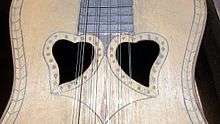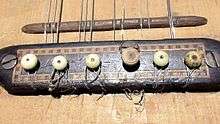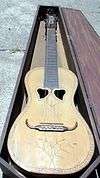Viola da terra
|
Viola da terra | |
| String instrument | |
|---|---|
| Classification | String instrument |
| Hornbostel–Sachs classification |
(Composite chordophone) |
| Related instruments | |
| Viola caipira, Viola beiroa, Viola braguesa, Viola campanica, Viola de arame, Viola sertaneja, Viola terceira, Viola toeira, Viola amarantina. | |


The Viola da terra is a stringed musical instrument from the Portuguese islands of the Azores. It may have either 12 strings arranged in 5 courses, or 15 strings, arranged in either 5 or 6 courses. The strings are made of metal.
Construction

The viola da terra is constructed of wood with a traditional guitar "hourglass" shape for the body, a fretted neck, and headstock supporting the tuners. Traditionally the viola da terra had wooden friction pegs inserted from behind the headstock (see illustration), rather than the "watch-key" mechanism used on Portuguese instruments such as the Guitarra Portuguesa. Nowadays the Viola da terra usually has machine heads, similar to those of the classical guitar.
What at first glance appears to be the bridge is actually just the support for the bridge pins, which anchor the lower end of the strings. The bridge saddle is actually a separate piece, which sits on the soundboard of the instrument, in front of the bridge pin plate. Like all Portuguese violas, the number of bridge pins does not match the number of strings, and often there are two or three strings on each pin.
Scale length is about 540mm (about 21.3 inches), shorter than the modern classical guitar scale of about 655mm (abot 25.8 inches). There is also a smaller version (about three-quarter size) called a Requinto. While sometimes made with a single round sound hole, the viol da terra is more often distinguished by having a pair heart-shaped sound holes.
Tuning and further info
With 12 strings, the lower 2 courses have 3 strings each (2 of them high octaves and the third a low octave), and the higher 3 courses have 2 strings each, all tuned in unison. It is tuned A3 A3 A2•D4 D4 D3•G3 G3•B3 B3•D4 D4. With 15 strings and five courses, each course is triple strung, and the tunings is A3 A3 A2•D4 D4 D3•G3 G3 G3•B3 B3 B3•D4 D4 D4; with 15 strings and six courses, the lower three courses are triple strung and the upper three courses are double strung: E3 E3 E2•A3 A3 A2•D4 D4 D3•G3 G3•B3 B3•E4 E4 -- similar to the Viola terceira.[1]
